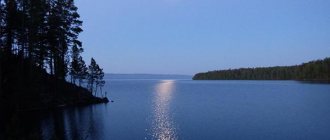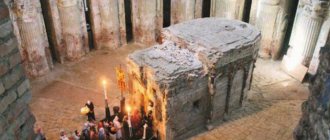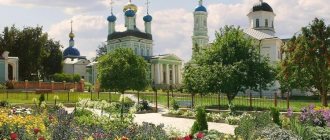Many of us are familiar with the biblical interpretation of the creation of the world and man. This is discussed in detail in one of the Old Testament books of the Bible - the Book of Genesis. The first part of the Book of Genesis tells about the life of the patriarchs (or forefathers), which, in particular, includes Adam, the first man created by God, the progenitor of all those living today.
According to the Bible, God created Adam and Eve and placed them in the Garden of Eden. Further, the Bible tells about the fall of Adam and Eve and their expulsion from Paradise for disobedience. As a result, Adam and Eve, and then all people, lost the ability to live forever, since they no longer had access to the tree of life, and were involved in the eternal struggle of good and evil.
Science and religion
To what extent do the events described in the Bible correspond to real historical events? We will not dwell in detail on the latest archaeological finds that confirm the theory that man is a product of evolution, and humanity arose in the Neolithic era. The important thing is that archeology dealt a serious blow to the biblical interpretation of the emergence of human civilization. Many began to consider the biblical story of the Garden of Eden a myth. But science is impartial, and the same archeology often presents surprises to scientists, destroying established opinions. The Book of Genesis contains facts confirming the reality of the Garden of Eden. So let's figure out whether he really existed.
Gardens of Eden in Islam
There is a mention of the Gardens of Eden in many religions: Jannah is the name of the Garden of Eden in Islam, it is located in the sky, not on the earth, devout Muslims will find themselves there only after death - the Day of Judgment. The righteous will always be 33 years old. Islamic paradise is shady gardens, luxurious clothes, forever young virgins and beloved wives. The main reward for the righteous is the sight of Allah. The description of Islamic paradise in the Koran is very colorful, but it is made clear that this is only a small part of what actually awaits the righteous, for it is impossible to feel and describe in words what is known only to Allah
The Bible Gives a Hint
Modern anthropology and the Bible agree on one thing - humanity began about seven thousand years ago. The second chapter of Genesis describes the geographical location of the Garden of Eden. It says here that God about seven thousand years ago created a beautiful garden in the east of Eden, where Adam and Eve appeared. A river flowed from Eden to irrigate Paradise and was divided into four channels: Pison, flowing around the entire land of Havilah, rich in gold and precious stones, Tikhon, flowing around the land of Cush, Hiddekel (Tigris) and Euphrates. It is known that the Euphrates and Tigris flowed through ancient Mesopotamia, located in the territory of modern Iraq. The other two biblical rivers, according to medieval scholars, could have been located in Africa or India. Thus, the entire Ancient World could have been the Garden of Eden! However, Dr David Rowe, a history professor at the University of Oxford in England, argues that Eden could not have been that big. After all, Adam and Eve were expelled from Paradise to endure hardships, which means that the Garden of Eden was only a part of the Ancient World.
What is the Garden of Eden?
The Garden of Eden is a magical place that God created for the first man, created a wife for him, where, together with Adam and Eve, animals and birds lived in peace and harmony, beautiful flowers and wonderful trees grew. Adam cultivated and maintained the garden. All living things existed there in complete harmony with themselves and the Creator. Two wonderful trees grew there - the Tree of Life and the second - the Tree of the Knowledge of Good and Evil. The only prohibition in paradise was not to eat the fruits of this tree. By violating the ban, Adam brought a curse on the earth, turning the blooming Eden into the devil's Garden of Eden.
Fenced on four sides
Theologians believe that many stories in the Bible are based on ancient epic tales of Mesopotamia and Iran, which is confirmed by archaeological finds. The British Museum houses an ancient clay tablet that is more than three thousand years old. It tells the story of the Great Flood and how the Sumerian hero Gilgamesh escaped from the raging elements, like the biblical Noah, with the help of the ark. The museum also houses a seal from Mesopotamia, made more than four thousand years ago. It depicts a plot reminiscent of the story of the Fall of Adam and Eve. Interestingly, the name of the Garden of Eden in Hebrew indicates that this garden was enclosed on four sides. The ancient Persian name for such a garden is consonant with the modern name of Paradise in Romance languages. Moreover, the architecture of ancient Persian and Indian palaces, which have survived to this day, is a space fenced on four sides, in the middle of which there is a fountain and four reservoirs dividing the territory of the palace into equal parts.
Is it possible for a person to return to heaven?
A person's soul can return to heaven after death. But for this you need to lead a conscious and righteous lifestyle. Prayer and conversations with a priest will help with this. If a sin is committed, there is full recognition of it and a sincere desire to improve. Only then will repentance come.
It is important to remember that God loves each of us, because we are all His children. And if he sees that we need help or, conversely, a life lesson, he will always help.
Rate this post
The following two tabs change content below.
- Author
- Latest articles
Veronica Magomedova
In the footsteps of the Sumerian messenger
In Hebrew, the word for “channel” sounds like “rosh”, which is similar to the name of the Jewish holiday Rosh Hashanah, which marks the beginning of the new year. David Rowe suggested that since the Bible uses this word in the plural, it means that we are talking about the sources of the rivers of Eden. Therefore, Paradise must be sought in the mountainous regions where their sources are located. Where the Tigris and Euphrates rise, in the mountainous region between eastern Turkey and western Iran, are the sources of two more rivers that flow into the Caspian Sea. Therefore, the scientist decided that Eden was located in exactly that place, and went to Iran, to the Mesopotamia region, to make sure he was right. Here, on the territory of ancient Mesopotamia, ancient Sumerian fortresses - ziggurats - are still preserved. The Sumerian epic brought to this day the saga of the powerful king of Uruk Enmerkar, who once sent a messenger to the king of Aratta, a country north of Mesopotamia. The envoy began his journey in the ancient city of Susa, located on a plain along the banks of the Kerhe River in southwestern Iran. On the way to Aratta, the messenger passed seven gates, which in the Ancient world were considered mountain passes and gorges. It is interesting that in the Hebrew epic the number seven was considered sacred, since it was on the seventh level of paradise that Adam and Eve lived. The valley into which the messenger descended from the mountains to meet the king of Aratta is designated in the ancient Sumerian language by the word “edin”, so many scientists associate the origin of the name - Eden - with him.
Demons of the Garden of Eden
The bliss of Adam and Eve in paradise did not last long. The first people did not know evil, without violating the only and main prohibition - not to eat the fruits of the Tree of Knowledge. Satan, noticing that Eve was inquisitive, and Adam was listening to her, taking the form of a serpent, began to persuade her to try the fruit of the forbidden tree: “People will become like God...” Eve, forgetting about the ban, not only tried it herself, but also treated Adam. Much knowledge - many sorrows, the Serpent in the Garden of Eden made the unlucky ancestors make sure of this when, for disobedience, the Lord doomed them to illness, old age and death.
Following the war chariots of the Assyrians
The seven gates are also mentioned in a clay tablet kept in the Louvre. It describes the military campaign of the Assyrian king Sargon II against the ruler of Aratta. On the way to the Manakhan Valley, the king overcame seven mountains, passed through gorges, crossed mountain rivers and finally reached the Surikash area in the country of Mannev with his army. Then he went further north and arrived in the Aratta valley, the same place where the envoy of King Enmerkar also sought to go. Dr. Rowe used a satellite image of the area and this is what he found. In front of him stretched a valley, in the western part of which Lake Urmia was located, inaccessible mountains rose above the valley from the north and south, and in the east, between the mountain ranges, a narrow passage was clearly visible connecting the valley with the outside world. To the north of the valley, in an area with the ancient name Kush, the same one mentioned in the Bible, flows the Aras River, which after the capture of Persia by Muslims received the name Tikhon. To the southeast of the valley flows the Kizel-Uizon River. But how did the Persian Vizon become the biblical Pison? This is explained by the replacement of the sound “u” with the sound “f” when translating the ancient Iranian name into Hebrew. Also, the Persian name of the area Nokhdi changed to the Hebrew name of the land of Nod, which was located east of Eden. Adam's son Cain was banished there after the murder of his brother Abel.
Was there a global flood? When and where was the flood?
I. Aivazovsky. Global flood. 1864
By the way, in Greek the Flood sounds like “cataclysmos” - literally this is the cleansing of the world, the cleansing of human sins. Obviously, it could only affect human habitats. At the time of the Flood, there were no people in Australia or America, which means there was no need to flood them. The Flood had a specific area - the territory of the Middle East and North Africa, Southern Europe, and the Caucasus. Perhaps the time of the flood coincides with the end of a major glaciation. We have repeatedly discussed this topic with my friends, geologists and paleontologists (by the way, I am a geologist by first education). Then, at the end of the Ice Age, there could have been a sufficient level of water rise. There was a flood, as evidenced by the epics of many peoples. The question is, was it universal? Sometimes a fantastic picture is drawn that the Flood covers the entire earth. The question arises: where did the water go in such quantities if the peaks of the highest mountains were covered (Ararat, for example, is more than five kilometers above sea level)? Imagine - a five-kilometer shell of water around the globe! This fantastic picture is typical of the explanations of Protestant creationists and of the numerous little books about the Flood that American fundamentalists publish and which some adherents of Orthodoxy rewrite. But this says more about human psychology than about correct interpretation of Scripture or science. For example, when in America the Grand Canyon is declared to be a trail of water leaving after the flood, this is a rebellion against evidence and a sober view of the world. It is impossible to attribute all traces of weathering, as well as sedimentary rocks of the earth's crust, to the consequences of the Flood.
An interesting point in the Holy Scriptures - it says: all the sources of the great deep were opened (Genesis 7:11 ). But in Hebrew, the abyss is a synonym for the sea. By the sources of the great abyss we must understand the invasion of large waves as a result of tectonic processes. That is, it was a tsunami. The traces of this catastrophe are not all sedimentary rocks of the earth, as naive creationists write, but only sedimentary deposits of the Quaternary period. Although, it must be said, no geologists have conducted systematic research on this topic. But if someone undertook to compare a set of data specifically on Quaternary geology, on the regions of the Middle East, North Africa, and so on, then the picture would become more clear.
The Bible: A Reliable Source for Eden
Almost all scientists and religious leaders in their research into the location of the Garden of Eden were guided by the texts of the Bible. It gives very precise instructions on where to look for this blessed place. If we take this information as a basis, it becomes clear that the Lord placed the Garden of Eden on land washed by four rivers - the Tigris, Euphrates, Pheson and Gehon. Their waters nourished the paradise and gave it life.
Based on this data, many scientists began to look for Eden to the east of Israel and the only suitable place that could lay claim to the cradle of humanity is Mesopotamia. However, this hypothesis contradicts the official scientific version, which claims that human civilization originated on the African continent and nothing else. Is the Holy Scripture wrong and the Garden of Eden was located in Africa? Don’t rush to draw conclusions, everything is not at all what it might seem at first glance...
LiveInternetLiveInternet
Friday, July 19, 2013 23:24 + in quote book Source Did the Garden of Eden really exist, or is it just a metaphor? And if there was, then where exactly was it located? How much simpler it was before, when we knew that there is official science that knows everything and can explain everything, and that what goes beyond its scope simply cannot exist, because it can never happen. Now, when the authority of this know-it-all has been shaken, so many different scientific and near-scientific versions and hypotheses have appeared, often mutually exclusive, that the brain simply refuses to accommodate this contradictory information. There are more answers than questions! Didn't the first people appear in Africa? Science claims that Homo sapiens appeared approximately 150 thousand years ago in the region of central Africa and from there slowly but surely began to spread throughout the planet. This is one of the few postulates that has never been questioned. However, recent discoveries by archaeologists indicate that this may well be a scientific fallacy. In 2008, during excavations in the Qesem Cave, Israeli archaeologists found household items of ancient man, and among them human remains. And there would be nothing unusual about this if there were no “but” - their age is 400 thousand years, despite the fact that they are no different from modern humans.
But how could modern people end up on the Mediterranean coast 200 thousand years before the official appearance of man in Africa? The surroundings of Qesem, according to the Bible, are the very place where paradise was located, and in it the first people of the planet Adam and Eve. So what happens, the Old Testament story is not a myth at all, and the recent discovery of archaeologists confirms this? The path to the biblical garden where Adam and Eve lived is described in detail in the sacred books. The scientists' task was to decipher the Bible and draw a real route. Is the Sumerian abode of the gods Dilmun an earthly paradise? The book of Genesis says: and the Lord planted a paradise in Eden in the east. There is another landmark for Eden: it is washed by four rivers - the Euphrates, Tigris, Gihon and Pheson. It can be assumed that paradise is located east of Israel, on the banks of four great rivers. There is only one place on the map of the Earth that exactly matches this description - Mesopotamia. Between the Tigris and Euphrates rivers in the 42nd century BC. Indeed, there was one of the most ancient civilizations on our planet - the Sumerian kingdom. Contemporaries considered their lands heavenly. The image of paradise is inextricably linked with a warm climate and blooming gardens full of ripe fruits. In Mesopotamia, gardens bloomed all year round and one of the wonders of the world, the Hanging Gardens of Babylon, also comes from here. It’s so easy to believe that this is a gift from God! In fact, all this was achieved with great difficulty. The Sumerians invented the potter's wheel and wheel, brick and lunar calendar, writing, mathematics, architecture and even the school system. Archaeological excavations in Mesopotamia show with what difficulty people achieved new knowledge; each, from a modern point of view, insignificant event (the invention of the wheel, cuneiform, etc.) took hundreds and thousands of years. Sumerian tribes settled in the interfluve after the Great Flood. They called their land Kengi - the land of the righteous, and they themselves believed that in the east of Mesopotamia, where the sun rises, there are paradise lands, the abode of the gods Dilmun. Sumerian myths exactly repeat the biblical descriptions of paradise - this is a land of eternal bliss, where there is no disease or old age. Perhaps there really was an earthly paradise east of Mesopotamia. But where did he disappear to? There is a version that the heavenly lands were washed away from the face of the earth by a global flood. As a result of the disaster, the territory where the Garden of Eden was located dropped by one and a half dozen meters, and the waters of the Persian Gulf flooded it. Now there is a large lake Khor. That is why the biblical and Sumerian legends about the earthly paradise between the Tigris and Euphrates rivers are so similar. Is this the same paradise to which people have been striving to return for many millennia? Where do the biblical rivers flow? Most scholars agree that the Garden of Eden was located in ancient Mesopotamia, where modern-day Iraq, northern Syria and southern Turkey are located. This belief is based on indisputable archaeological facts of the appearance of the first domestic plants and animals there. If we accept the version that Eden was located between the Tigris and Euphrates rivers, then where did the other two rivers mentioned in the book of Genesis – Pheson and Gihon – go? Archeology professor Juris Zarins suggests that the site of the Garden of Eden is now buried in the waters of the Persian Gulf near Bahrain. The Karun River flows nearby and its name is very similar to the name of the biblical Gihon River. In the Orthodox Church there are two versions of the correspondence of these rivers to modern ones. According to one version, these are the Ganges and Nile rivers, and according to another, the Ganges and Indus. It should be borne in mind that at the dawn of its existence, our planet looked completely different. The single continent of Pangea was washed by the waters of the ancient ocean, then it split into continents, which are now drifting. Facts confirming the movement of continents were discovered back in the fifties of the last century. So, based on a map of continental drift and topographic analysis, researchers came to the conclusion that deep in ancient times the Tigris, Euphrates, Ganges and Nile rivers had a confluence, as described in the Bible, and the Nile and Indus were one river. With the rupture of a single continent, the rupture of the biblical rivers also occurred. Here's another interesting fact. At an altitude of 720 km above the earth, geosynchronous satellites made an amazing discovery: in ancient times, on the territory between the Tigris and Euphrates rivers there were not two rivers, but all four, as indicated in the Bible. But there are other hypotheses; some believe that the other two rivers should be sought in Africa or even China. Is Eden a geographical place or an era? Based on the theory of Pangea, the search for paradise and the cradle of life on earth took a completely different direction. Scientists have put forward a sensational hypothesis: Eden is not a geographical point at all, but an era during which the entire planet was a blooming Garden of Eden. Then the planet had a completely different climate, which was created by a steam-water dome that surrounded the earth. In the period that belongs to Satya-Yuga - the Paleogene period, especially its early part (Paleocene and Eocene - from 65 to 35 million years ago) - there was no north and south as such. The whole earth was an oasis, this is proven by geological data.
Experts explain such climatic conditions by the fact that in addition to the atmosphere, the Earth also had a second water-steam shell. The planet was covered with a protective dome, inside which there was no atmospheric circulation, there was no wind or weather disasters. The presence of a water-steam shell also explains another phenomenon of heavenly life - immortality. The protective dome reflected ultraviolet rays, which are the main and almost the only source of aging of the body. It is for this reason, according to scientists, that people who lived in paradise, that is, in that era, could be practically immortal. For the water-steam shell created conditions for a high oxygen content in the atmosphere, and therefore conditions for a completely different biological existence. However, gradually the steam dome was destroyed, as a result, not only the height of people, but also life expectancy naturally decreased. At first it fell to a thousand years, as we know, the Bible writes about this. Then, when the blue sky appeared overhead, life expectancy was reduced to the current hundred years. Is the North Pole humanity's lost paradise? This map appeared in the mid-16th century, showing the North Pole and the Arctic continent - four islands separated by straits. They correspond exactly to the biblical descriptions of Eden. The author is the famous cartographer Gerhard Mercator, a man who devoted his life to the search for paradise lands. This cartographic atlas was published in Germany back in 1595; its incredible accuracy made it a bestseller. True, there was one oddity in the atlas - for some reason the author drew continents at the North and South Poles, which no one knew about at that time. Contemporaries considered this a quirk of the old cartographer and forgot about this small inaccuracy. However, time has shown that Mercator was right - 400 years later, land at the North Pole was found. In 1948, Soviet scientists discovered a mountain range at the bottom of the Arctic Ocean, stretching for almost 2,000 km. They called it Lomonosov Ridge. The Lomonosov Ridge was studied in detail by scientists; it turned out that there was flooded land at the bottom of the ocean. The mountain slopes are cut by canyons with traces of wind erosion. At the bottom, under a layer of silt, there are pebbles, boulders, gravel, sand - rocks that the sea surf has worked on. Scientists no longer doubt that there was a continent at the North Pole that sank under water several thousand years ago. How did Gerhard Mercator, an armchair scientist who never left his town, know about the existence of an unknown land in the Arctic? They say that when compiling the atlas, he used the Bible and ancient maps that were brought to him by sailors from different countries. Mercator was sure that at the North Pole he had found a paradise lost by mankind, an ancient homeland where the first people appeared. But could the land beyond the Arctic Circle be paradise? For six months it is shrouded in darkness, and only on the horizon do glimpses of the northern lights appear every now and then. According to some researchers, only the circumpolar region can be the birthplace of humanity, since many years ago on our planet, conditions suitable for life developed primarily at the poles, where today there is eternal ice and permafrost. Perhaps this is why migratory birds migrate north every year; they are called to this dead land by the genetic memory of a warm ancestral home. Scientists claim that during the interglacial period there was an ideal climate that can be compared with modern African subtropics, and there is real scientific evidence of this. There are other hypotheses for the location of the Garden of Eden; some researchers even place it inside the hollow Earth. However, I believe that the mystery of the lost paradise will remain a mystery to us for a long, long time.
| Categories: | Interesting |
Tags:
Garden of Eden versions and hypotheses interesting
Cited 2 times Liked by: 3 users
Like share
0
Like
- 3
I liked the post - Quoted
- 0
Saved
- Add to quote book
- 0
Save to links
Liked3
0
Garden of Eden: versions and hypotheses
We have already said that the most suitable place for a divine garden is Mesopotamia. Indeed, one of the most ancient civilizations on the planet existed here - Sumerian!
Archaeologists claim that the Sumerians lived on a beautiful land where gardens bloomed and trees bore fruit all year round. The amazing climate made it possible to harvest several harvests a year, and deep rivers supplied the inhabitants of the kingdom with much-needed moisture. The Sumerians managed to reach incredible heights in the development of culture; they are credited with various inventions and even the ability to perform complex surgical operations. Is this not a divine gift received as compensation for expulsion from Eden? Perhaps... After all, in Sumerian legends there is a story about the land of the Gods, located to the east of the kingdom. There was everything a person could wish for. However, due to the global flood, the paradise disappeared from the face of the earth and is now located at the bottom of the Persian Gulf.
Science draws an amazing analogy between the description of Eden in Sumerian legends and the Bible; moreover, in both sources the dates of the Flood coincide, which explains the disappearance of the divine garden. However, is this the place that can be considered the ancestral home of humanity? Is this the same Garden of Eden and where to look for it if Sumerian sources are still wrong?
Northern Eden
There is another popular version about the location of the Garden of Eden. It is directly related to the ancient geographical map of the 16th century. It was created by the famous medieval cartographer Mercator, who never left the walls of his office. However, all his life he studied ancient manuscripts and collected maps brought by sailors from different parts of the Earth. As a result, he drew a surprisingly accurate map, but one nuance cast doubt on the scientist’s entire activity - at the North Pole he located four islands forming a continent divided by rivers. This was considered a quirk of Mercator and this inaccuracy was forgotten for many centuries. However, in the middle of the last century, Soviet scientists discovered an underwater mountain range that was once on the surface of the earth. This is proven by the rock samples taken and the outlines of this ridge, dotted with canyons formed under the influence of surf and wind.
This discovery revived interest in the ancient Mercator map. After all, the lands on it were depicted without ice, which means that in the Middle Ages it was quite warm there. Many scientists confirm this version; moreover, they believe that the North Pole could very well be Eden. After all, this ancestral home of humanity is mentioned in the legends of completely different peoples of the planet. Interestingly, birds always migrate north. Perhaps this ancient memory directs them to where there once was a Garden of Eden, created for joy and eternal life.
Cradle of Humankind
Science has long answered the question about the time of origin of Homo sapiens and the place of its settlement. All school textbooks indicate that approximately 150,000 years ago our ancestors appeared in Africa, who then settled throughout the Earth.
This information was accepted for a long time as the only correct version, but nine years ago, Israeli archaeologists conducted excavations in the Qesem Cave. The discovery of human remains dating back 400,000 years was a sensation. This completely overturned the established idea of the origin of humanity, because the found remains belonged specifically to Homo sapiens, who was absolutely no different from you and me. So have Israeli scientists really found the exact place where the Garden of Eden was, which became the ancestral home of humanity? Unfortunately, everything is not so simple - until the Bible allows modern people to penetrate its secrets.











